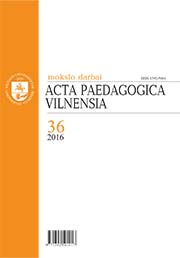Koedukacija versus vienalytis ugdymas mokyklose: tyrimų teritorijos apibrėžtis
Coeducation versus single-sex education in schools: definition of the fields of research
Author(s): Danguolė GervytėSubject(s): Gender Studies, Recent History (1900 till today), School education, History of Education, 18th Century
Published by: Vilniaus Universiteto Leidykla
Keywords: Coeducation; single-sex education; history of education from the point of view of sex; aims of the school and curricula from the point of view of sex; educational achievements;
Summary/Abstract: The most important event in the educational revolution that happened at the beginning of the XX c. was probably the spreading of coeducation, a fact that makes our present schools radically different from traditional ones: boys and girls are educated together, their curricula are the same and so are the diplomas that sanction their achievements at school. The article analyses the question of coeducation and single-sex education, which is raised anew nowadays as a field of theoretical research. We analyse scientific articles and pick out the main themes of the discussion on coeducation vs. singlesex education in the contemporary discourse. The aim of the article is to define the field of educational research on coeducation and single-sex education. The goals of the research that we point out reflect the main questions which are raised nowadays about coeducation: 1. Analyse the appearance of coeducation with its historical context and causes. 2. Compare the goals of coeducational and single-sex schools, their curriculum and environment. 3. Reveal the links between the results of education, the methods applied and the sex of the students. Coeducation in the educational system followed the process of the schooling of girls that started already in the XVIII c. It was influenced by a new understanding of the necessity of instruction for women, even if they do not participate in public affairs, and by the growing understanding of “education for all” in the upper spheres of society as well as among the poor. At the beginning of the XX c., as the first coeducational schools were opened, the supporters of coeducation based 86 Įteikta: 2016 02 07 Priimta: 2016 04 10 their arguments on economical and ideological grounds, and also on the similarity of coeducation to education in the family context. Sometimes, however, single-sex education is the only possibility and can even be understood as promoting women’s emancipation. The transition from single-sex to coeducational schooling brought about changes in the curricula; it also changed the profile of the educational community and school environment. In present day educational organisation, if the school tries to attend to the needs of individual students, the suggestion would be to form flexible groups, if needs be according to their sex, if ever that helps to better adapt didactical methods and curricula, while maintaining the principle of equal opportunities and facilities.
Journal: Acta Paedagogica Vilnensia
- Issue Year: 2016
- Issue No: 36
- Page Range: 72-86
- Page Count: 15
- Language: Lithuanian

